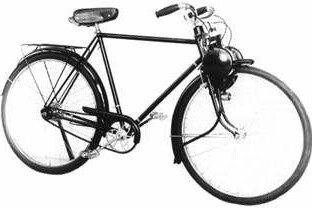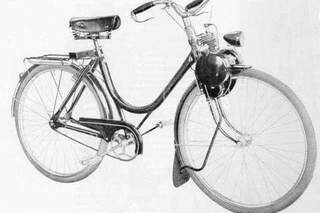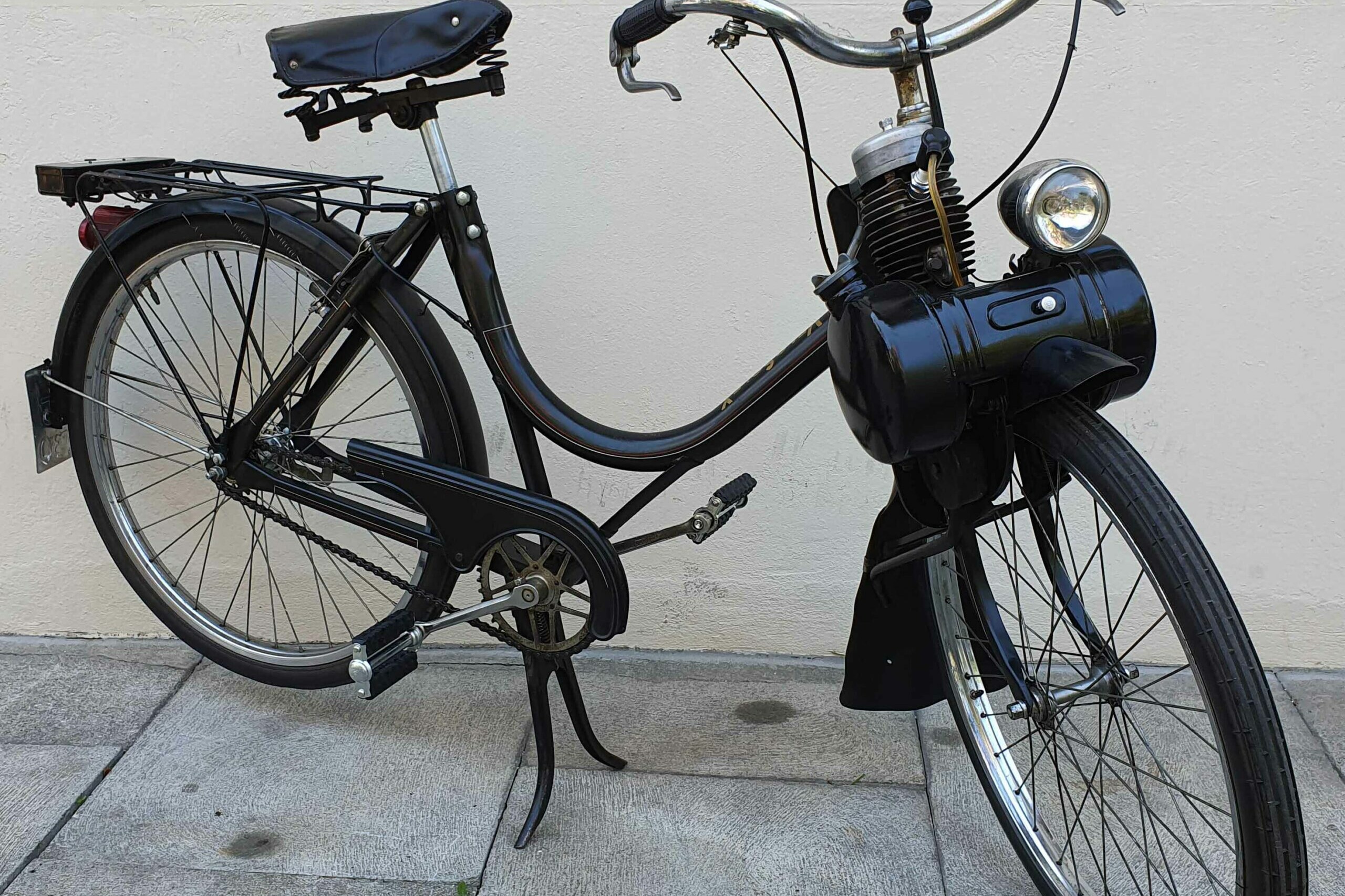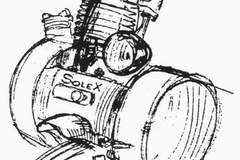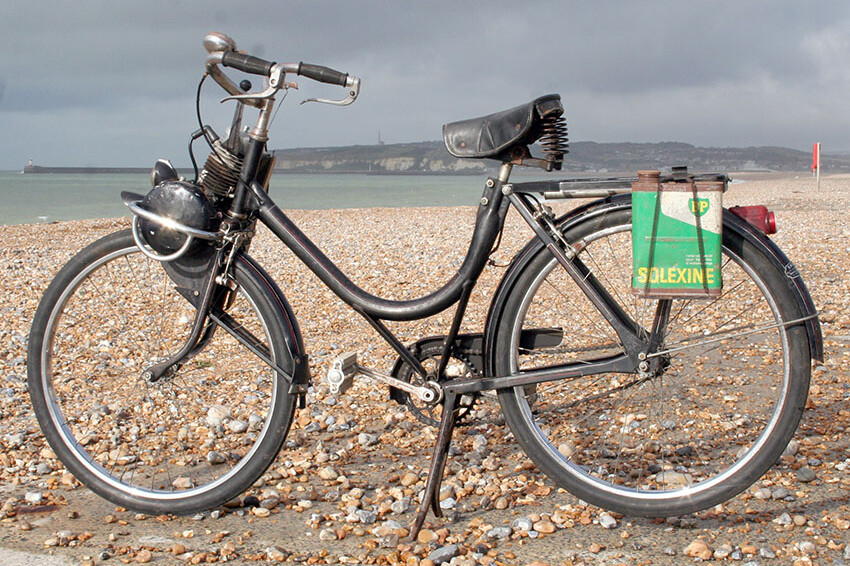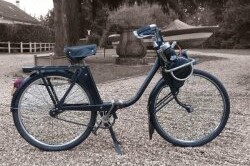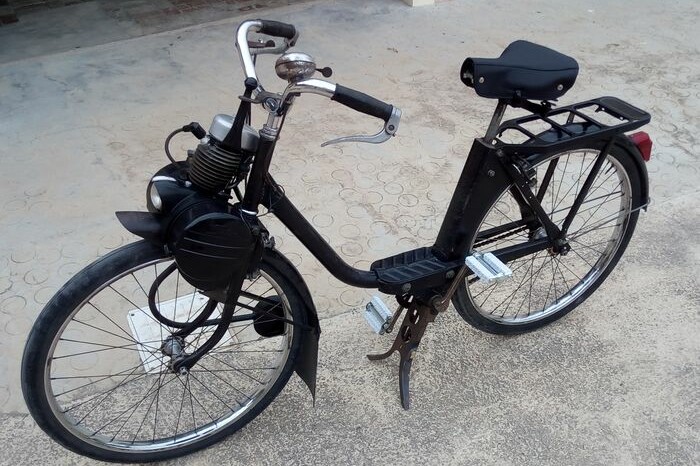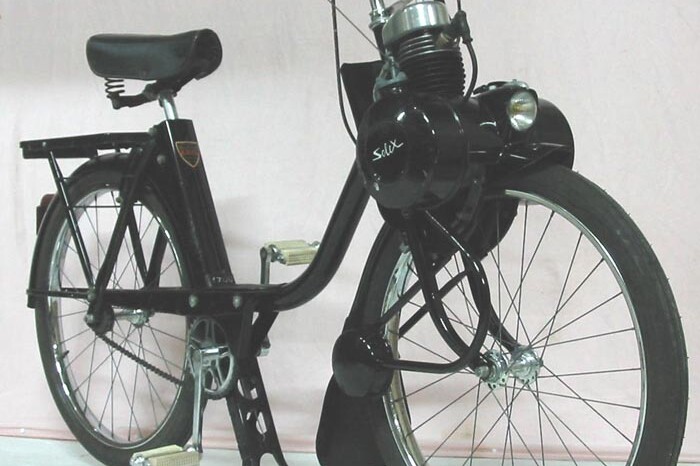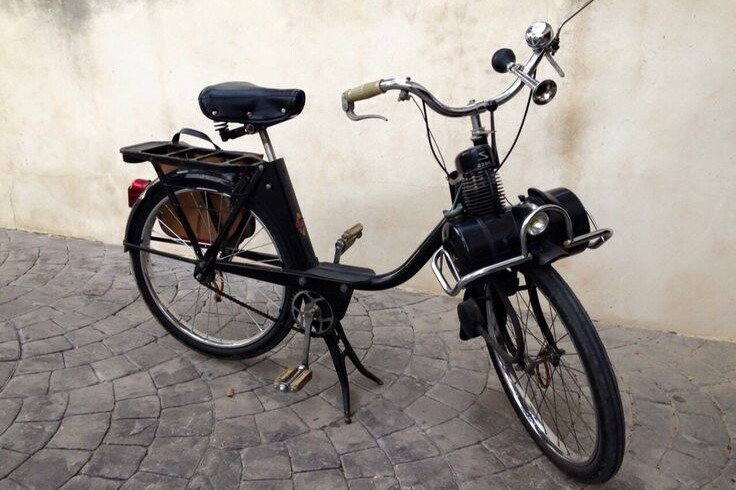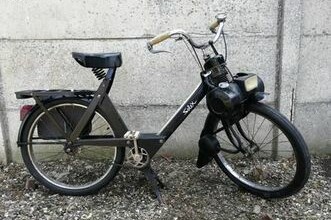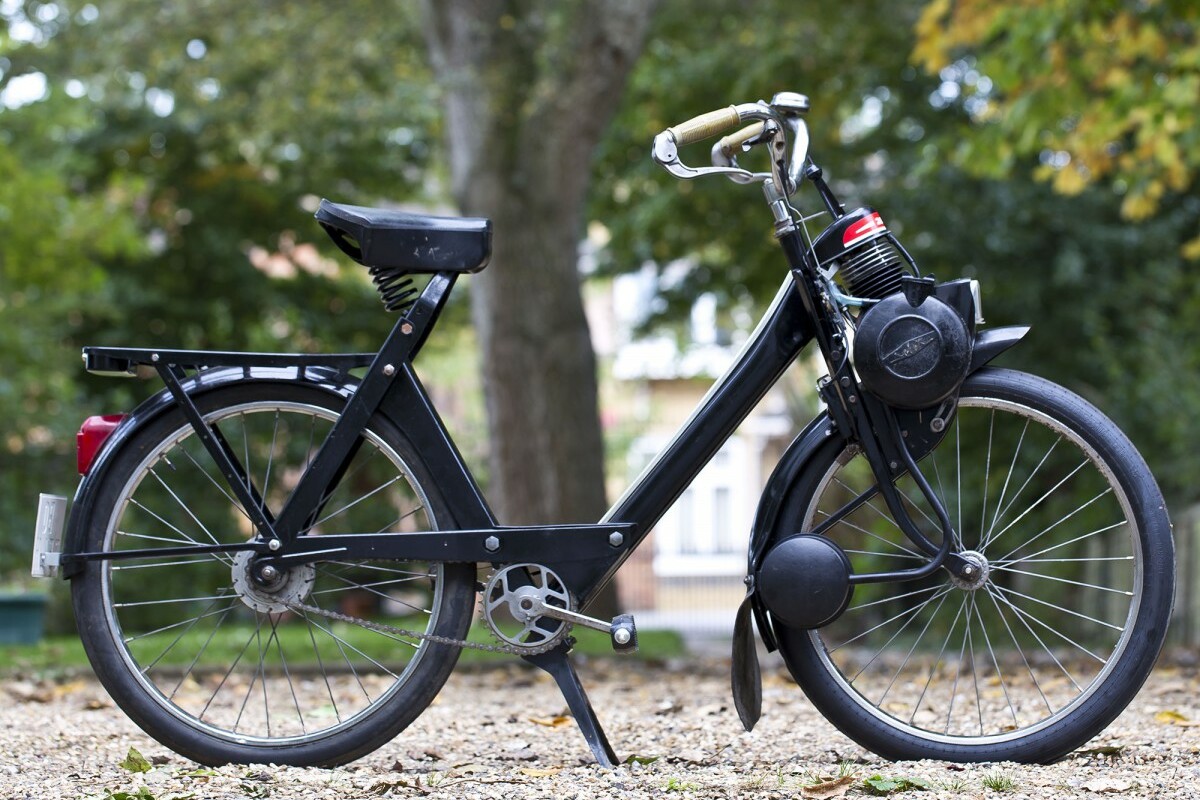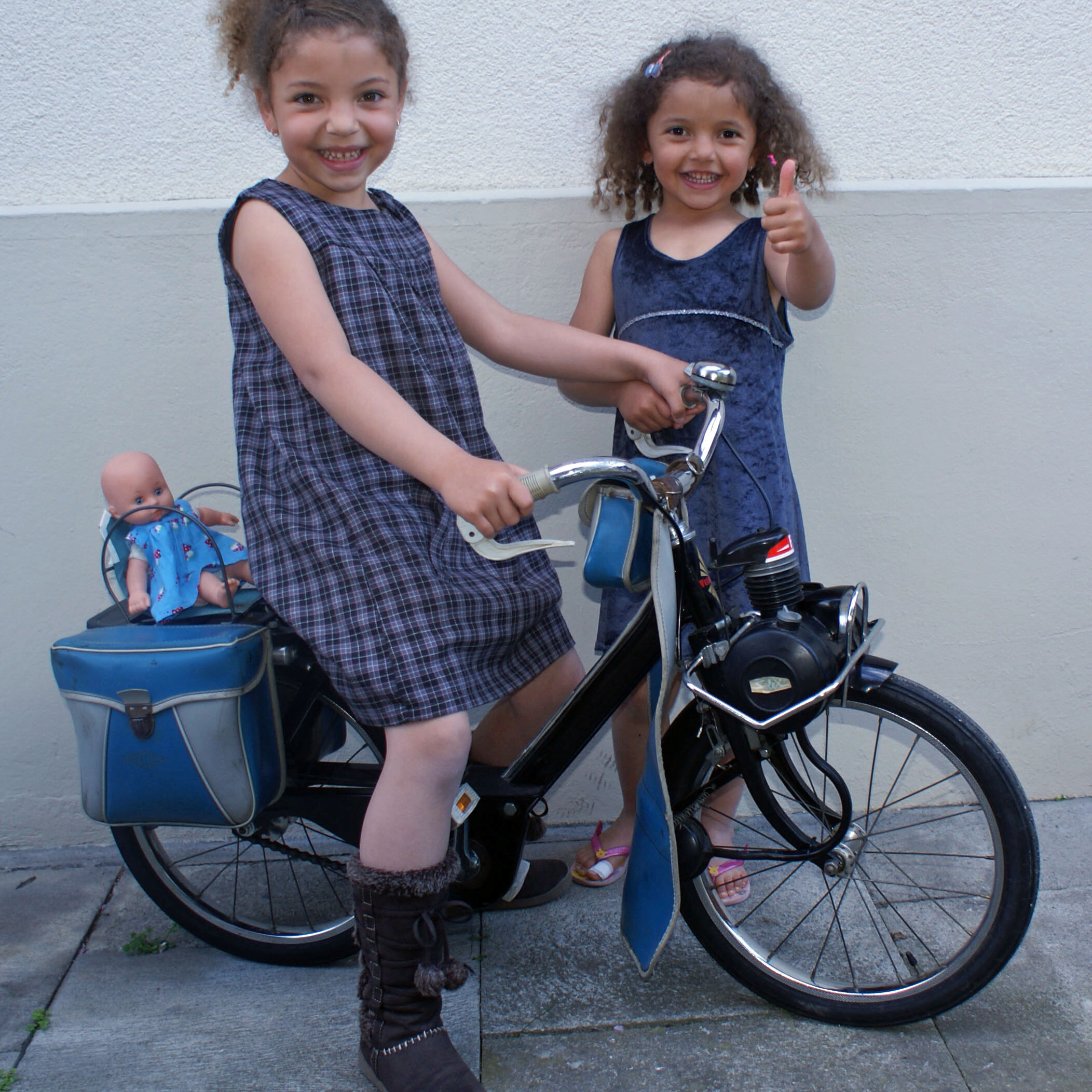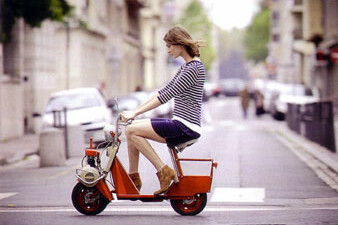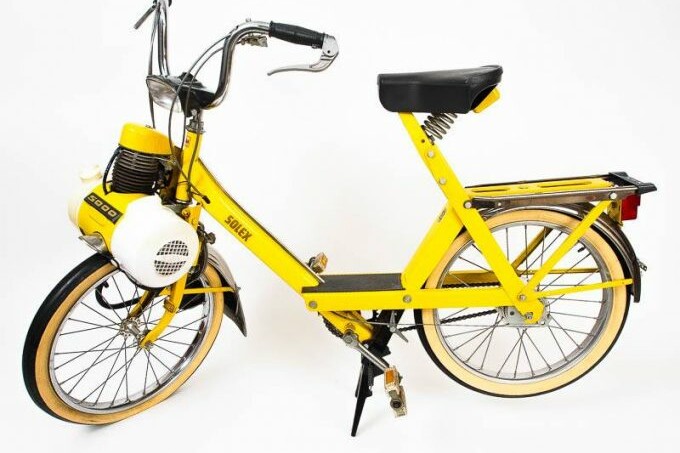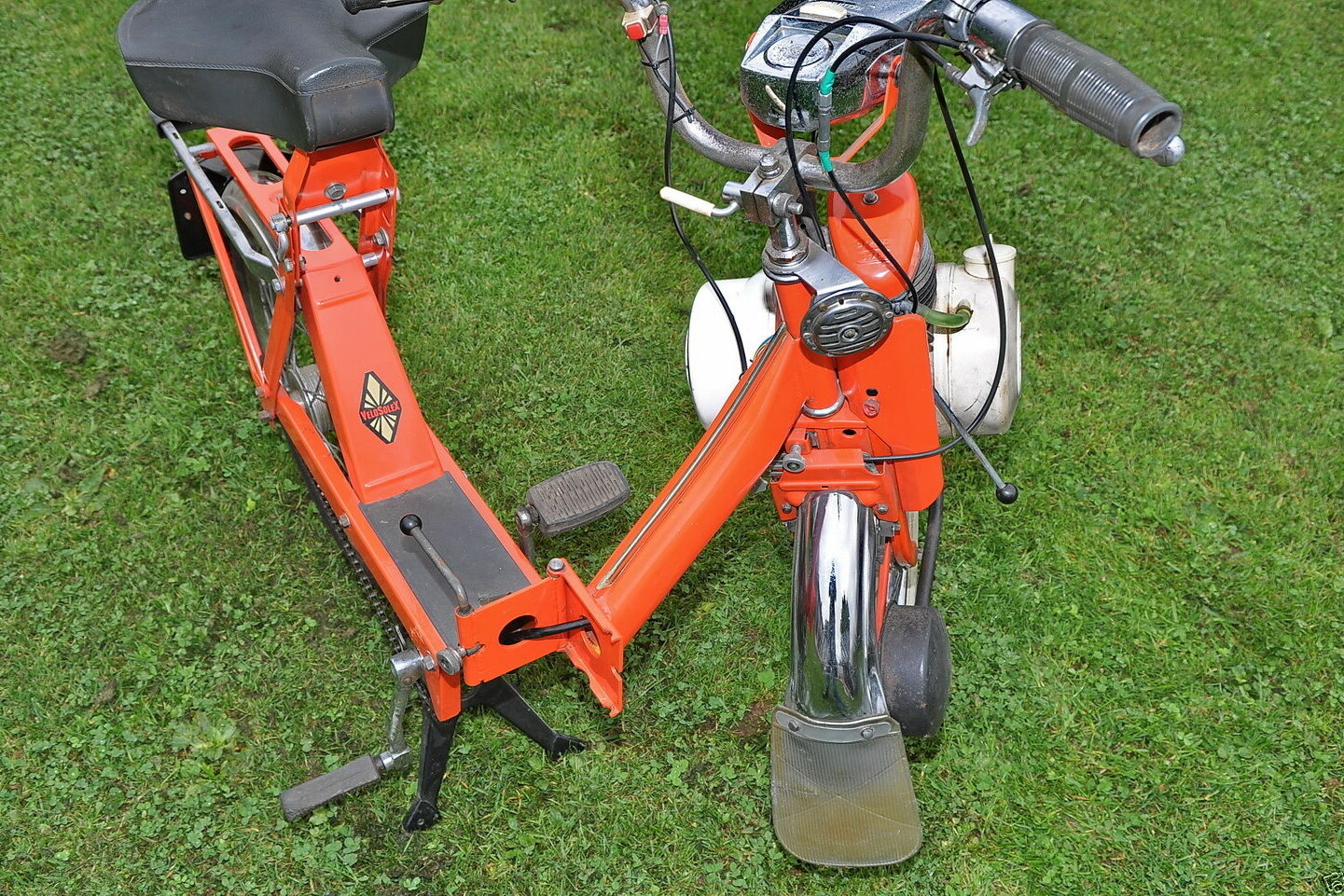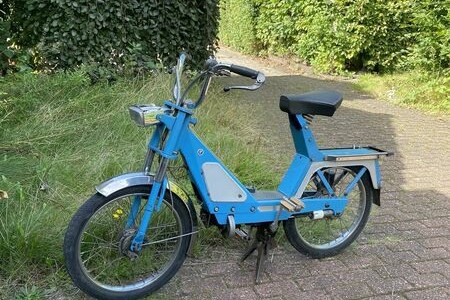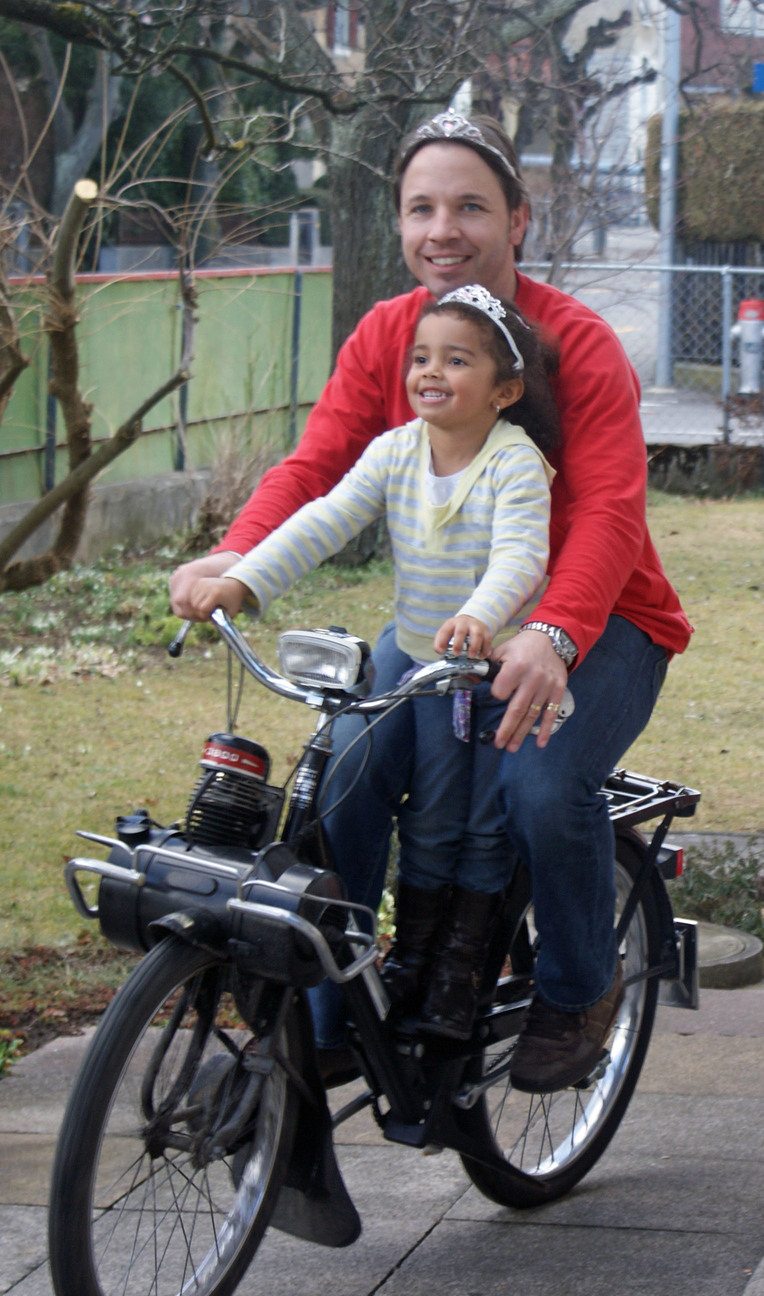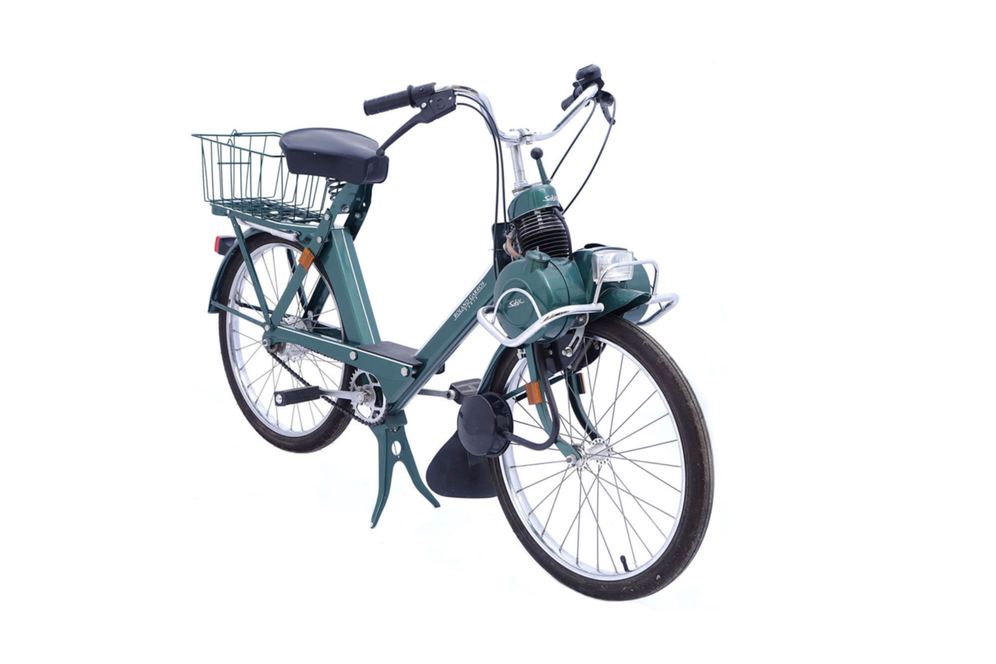1941: The first prototype
At the end of 1941, the first Solex prototype was made when a 38 cc motor (which had no cover and could not be removed) was fitted over the front wheel of an “Alcyon” men’s bicycle. The headlight was mounted on the left under the engine, while on the right, directly under the tank, was the muffler, from which a pipe curved down to the mudguard. The front wheel was equipped with rim brakes, the rear wheel with coaster brakes.
1946: The first series
The first series of VeloSolex bicycles, whose production started in April 1946, had an engine displacement of 45 cc and generated 0.4 hp at 2000 revolutions per minute.
The biggest production changes for the series were smaller wheels (650s), rim brakes for the rear wheels and a more generous “lady-friendly” frame, in which a tube led from the saddle carrier in an arc to the steering head. The fork now consisted of oval tubing. The rear wheel fork was no longer welded but screwed on. The tank had only 1 litre capacity which, however, was enough for 100 kilometers. The 1946 Velosolex weighed 25 kilograms. In a brand new factory in Courbevoie, France 15 bikes were assembled daily.
Hispano Suiza: 1948-1957
The 45cc and 49cc VeloSolex were assembled between 1948 and 1957 in the Hispano Suiza factories. The cylinder heads were Swiss made as were many other parts, notably the famous brown leather saddle (Viktor Raetzer).
For the Swiss bicycles a number plate was required, beginning characteristically with the letters HS (for Hispano Suiza). Between 1948 and 1957, the production of the 45cc and 49cc models was estimated at 14,750. The brand name Hispano Suiza still exists today. The company is a branch of the SAFRAN group, currently based in Colombes, France in the Haut de Seine. They are affiliated with the aerospace companies Airbus and Ariane.
1951: For the first time with the engine lever on the cylinder
1951 was the year for practical improvements. The engine lever was now screwed onto the cylinder head and a hook on the handlebars held the engine. The wheel size was again reduced to 600s, making the Solex 8 cm shorter. The lack of a throttle grip gave riders an “all or nothing” driving style. Speeds of up to 28 km/h were possible and decompressor and rim brakes were used. In 1954, Solex adopted precise model designations with serial numbers based on the first manufactured engine number of the given model.
1956: Velosolex 660
In 1956, the 660 model was introduced. Coming from the steering head, the round frame tube ended above the pedals under a small running board and the saddle carrier was now folded from a piece of sheet metal. The lamp was mounted in the plastic cover at the front under the cylinder. At 228,183 units, the 660 model beat the previous year’s production record by another 10 percent.
1957/58: Velosolex 1010/1400
Technical developments continued rapidly. A new cylinder with piston and a new S-shaped exhaust with muffler on the mudguard were introduced. In addition, a larger oval air filter and a rod made of sheet metal for the rear mudguard characterized the Velosolex 1010 from 1957.
In 1958, even smaller wheels (550s) were installed and better tire covers were available for the 1400 model. A total of five different factories produced 288,309 Solex units.
1959: Velosolex 1700
In 1959, Solex adopted for the 1700 series the “Compound” automatic centrifugal clutch from Velo-Vap and installed it together with a fan on the left-hand side. This cooling system had become necessary because the engine could now continue to run even when the vehicle was stationary.
For optical symmetry, the petrol tank was moved to the right side and enlarged to 1.4 liters. Velosolex 1700 was offered at the same price as the 1400 model before it. 288,194 units were assembled in 1960. The five factories were now producing 275,000 units a year.
1961: Velosolex 2200
In order to comply with new regulations regarding interference suppression in vehicles, the 2200 models from 1961 had the spark plug screwed into the cylinder head from the top and then covered by the air filter. This was now painted black instead of metallic and bore with white lettering “S 2200”. But the most important change was not visible to the eye : horsepower was increased by 40% from 0.5 HP to 0.7 HP!
Production rose again to 300,070 units in 1961. Corresponding to demand, 311,076 units were built in 1962, 340,000 in 1963 and 380,000 in 1964, a record year. That was 1500 VeloSolex units produced daily!!!
1964: Velosolex 3300
The “S 3300” model was introduced in Paris in 1964 with a completely new angular frame and almost square cross section. The frame was deliberately screwed together and not welded so that it provided a certain elasticity. The seat was now a bit wider and only supported by a spring. The headlight was now also angular to match the shape of the frame and a drum brake was installed for the rear wheel. The petrol pump could no longer be dismantled and the holes in the crankcase were changed slightly.
1965: Velosolex 3800
The era of the Solex 3800 series began in May 1965. Little was changed on the engine, but advertising promised 50% more power. Velosolex bicycles were no longer exclusively black from top to bottom. The first splash of color was introduced: a red stripe around the air filter with the inscription 3800 in white. The fuel tank, previously made of sheet metal, was now made of plastic. The “Luxe” was available in blue or red, with brake levers mounted on the inside instead of the outside of the handlebars. Whitewall tires and stainless steel mudguards completed the new look.
From 1976 onwards, the company SIDES developed and built a light three-wheeled “delivery bike” based on the 3800 Solex model.
The Velosolex 3800 became very popular due to its ease of operation, reliability and low maintenance. It was also extremely economical to operate because it used little fuel and did not require costly repairs. Many people used the Solex 3800 as an inexpensive means of transportation for their daily commute or for short trips around town.
Although the Velosolex 3800 originally became popular in the 1960s, it maintains a loyal following to this day. There are still many enthusiasts who collect, restore and ride these classic models. The Solex 3800 has become a symbol of nostalgic charm and timeless simplicity.
The Velosolex 3800 is still the best-selling model on the market today.
1966: Solex F4 - Velosolex for children
In 1966, the Velosolex F4 was introduced as a novelty for children. This was a 2:3 scale copy of the full sized Solex. Some forty years earlier, André Citroen had done a similar thing with copies of his cars. The “petites Citroens” were powered by an electric motor. The F4 only had pedals, the engine was a dummy made of plastic. A sound generator simulated the engine start of a S 3800. A battery for the headlight was housed in the cylinder. Following in the footsteps of the “Citronettes”, the Solex F4 generated a loyal clientel. Solex salespeople were given a Solex F4 as reward and incentive for good work. The Solex F4 were manufactured from 1966 to 1975.
1968: Velosolex Micron
What would you call a small bicycle without pedals? A mini scooter or a supplementary motor vehicle? It was classified as a “Velomoteur” by the registration office, which resulted in a number of consequences: compulsory helmets, driver’s license, horn, speedometer, etc. To start riding, the Micron had to be pushed because there were no pedals. The engine of the 1968 production series came essentially from the 3800 model, but the engine lever was bolted to the right side of the cylinder head. However, the dimensions of the frame had been extremely reduced compared to the 3800:
Length 1.1 m (3800: 1.6 m), height 80 cm (95 cm) and the handlebar could also be folded down. The wheels had a diameter of just 22 cm. Available in red or blue with gray plastic parts, less than 4000 units of the Micron were built from 1968 to 1974.
1971: Velosolex 5000
In 1971, the 5000 model was introduced with smaller 16-inch whitewall tires, stainless steel mudguards, and higher handlebars with built in headlights. The luggage rack had been modified and the tool box was placed under the seat. The engine lever on the cylinder head was replaced by a new system operating to the right of the fork. In order to lower the motor with the drive roller onto the front wheel, the lever on the side of the motor now had to be shifted upwards. This lever system and the headlight attached to the handlebars were then also used to produce the 3800 series, without a change to its serial number designation (the same since 1965). The 5000 model was offered in white, orange-red, blue and yellow. The tank and alternator cover remained white, while the engine cover and tool box were matched to the color of the frame.
1974: Velosolex Plisolex
Starting in 1974, the 5000 series was also produced in a collapsible version, called the“Plisolex”. The engine could be removed in a few simple steps. According to advertisments, this took just 20 seconds. The foldable handlebars with clamp locks had brake handles bolted on the inside so that the throttle grip could be removed. Throttle cables with handles remained connected to the engine and could be stowed with it. The frame could be folded up at a kink point in front of the running board, and the saddle with the carrier could be lowered forwards. These rare foldable models were built until 1978. In addition, in 1974, a prototype of the 4600 model was presented. Intended for the American market, the 4600 series was a cross between a 3800 frame and a 5000 engine and included special accessories.
Model: Velosolex 6000 and Flash
The engine performance and optics of these models were not comparable to the VeloSolex. Some details (e.g. the handlebars) were taken from the 3800 series. Cardan drive and disc brakes at the rear. Tire size was 16 inches and available colors included white and blue. The Flash model was produced from 1968 to 1972 and the 6000 model from 1973 to 1974.
1988: Velosolex 3800 Motobécane (the last series)
The 3800 series was the only model still being built at Motobécane in Saint-Quentin, with only three quarters manufacturing capacity being used. The last of the 3800 series again had the headlight in the engine cover and the release lever on the cylinder. The brake levers were screwed to the inside of the handlebars and the frame was equipped with the standard side reflectors. In 1983 the factory in Pantin was closed and in October of the same year the Japanese giant Yamaha took control of Motobécane, which is now called MBK.
The sales figures had meanwhile taken a huge dive. In 1980, only 7077 units were produced and in 1981, just 2787 units! The final hundred units left the MBK factory with the inscription “NOSTALGIE”. 24 of them were auctioned off and ten more were made into modern art sculptures.
Could you rate us on Google (reviews)?
WE WOULD BE VERY GRATEFUL!
Link:
https://g.page/r/Cc-wzxeDwAoyEB0/review



